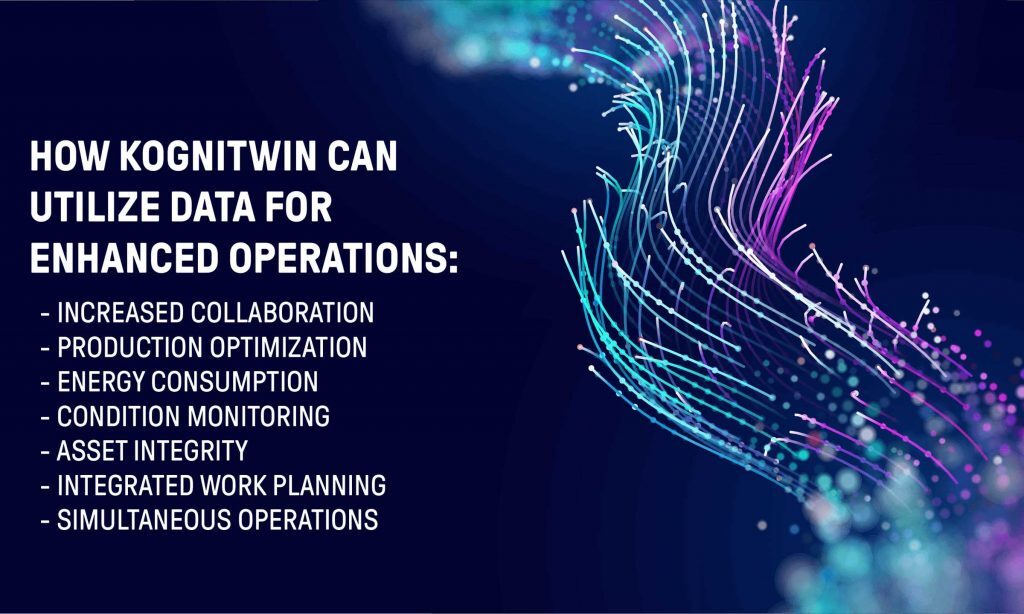3 March 2022
A better tomorrow: Your industrial work surface and data-driven operations

Data is much easier to come by these days. Sensors and data-recording tools gather information from equipment upstream and downstream, creating vast sets of data that when contextualized can provide a complete picture of your facility assets and their behaviours.
With all this data, it can be difficult to get useful insights when operators are exposed to issues such as disconnected data, outdated data, and data stored in different systems. How can Kognitwin, Kongsberg Digital’s leading industrial work surface, help you utilize data for enhanced operations?
Kognitwin is a virtual dynamic replica of your physical asset that integrates with existing information architecture and data flows to provide data-backed insights for improved performance and more autonomous operations. It unifies data from siloed enterprise systems and various sources including documents (for example from Assai), video streams from inspections, financial data, sensor data (alarms and events), engineering data, work processes, and time-series data.
This enables users to limit the amount of time spent searching for and structuring information. Data verification and validation are performed across systems, accelerating troubleshooting and improving data quality to unlock valuable insights across your value chain.
Historical, operational, and transactional data can be used within our digital system of engagement Kognitwin to contextualize data and drive operations for a better tomorrow.
Increased collaboration
Teams can access digital twin assets from any location - remotely, on-site, or from control rooms - to reduce non-productive time. Cross-team collaboration becomes a seamless experience as data is made accessible in Kognitwin, available for anyone to use in support of evaluating, prioritizing, and approving on-site work, integrating work planning, and predicting asset behaviour.
Production optimization
Within the energy and oil and gas industries, analytics and physics-based simulation tools are not new. However, they remain resource intensive with long processing times and limited real-time use, especially for complex applications of a dynamic nature. Data-driven solutions through a digital twin can speed up processing times and with Kongitwin’s hybrid machine learning approach, data-driven models can be trained with synthetic data derived from physics-based models. When properly trained, a digital twin’s processing speed and accuracy improves and users can access a more complete real-time understanding of facility performance, even in areas with less or a lower grade of instrumentation. Operators are enabled to position themselves for a sustainable, scalable digital transformation powered by useful data insights.

Energy consumption
In such an asset-heavy industry, energy consumption contributes to carbon emissions and reduced profit margins. That’s why Kognitwin empowers users to test data-driven configurations before executing actions, facilitating more proactive modelling that highlights outcomes such as flare or vent avoidance, lowered energy consumption, and other environmentally sensitive actions that can be optimized with a digital approach. Digital twins allow testing to take place with no risk of harm to people, the environment, or equipment. Estimated results of optimized asset performance include savings of up to 2 million USD yearly in reduced energy consumption,with a reduction of 0.5% in electricity consumption without affecting production.
Condition monitoring
Frequent shutdowns, equipment deterioration, and resulting revenue losses are costly for businesses, not to mention the burden and financials involved in resuming operations. In one case study involving hydrocarbon exploration and production, our domain and technical experts used Kognitwin’s wealth of data knowledge to emulate a customer’s plant in its normal operating conditions. Physical simulators and hybrid ML were implemented to detect potential errors, with deviations between actual and expected performance giving deeper insights into equipment failure and required service intervals. The resulting impact included an estimated reduction of 1-2 million USD per year due to minimizing the occurrence of unplanned shutdowns.
Asset integrity: Corrosion Under Insulation
Kognitwin’s data-driven operations link inspection results to tag data in existing data sources and 3D visualization so that the most important parameters for predicting CUI can be identified. Using the digital twin to integrate inspection results with design data, maintenance information, and line process data gives valuable insight into the CUI degradation mechanism. This in turn improves the accuracy in inspection point selection and condition prediction, helping to reduce operating costs and risks over an asset’s lifetime while increasing safety for CUI-related work environments.
Integrated work planning
With Kognitwin, users can navigate in 3D, measure distances, plan work packs, and locate and view different equipment layers. Navigation is enabled in a realistic 3D environment so that staff like maintenance engineers can reduce the number of on-site visits needed. The amount of time spent looking for information across systems is reduced, and information including transactional operations data and technical documents are available in the same place. Work planners can navigate freely between P&ID documents, take measurements, search for tags and linked documentation, get error notifications, switch between 2D and 3D views, and isolate components for a more focused overview supported by contextualized data.
Simultaneous operations
The twin view shows various work permits and filtering options in the 3D model for a more intuitive user experience. Users can look up details for risk evaluations, and site personnel can see work permits, technical deviations, and relevant notifications. This enables SIMOPS planning in which conflicts and risks are easily identified, and where users can review mitigations, evaluate risk, and approve permits for simultaneous operations based on the latest data available. Kognitwin equips maintenance crews, planners, and shift supervisors with the data-driven tools they need for thorough risk evaluations and optimal HSSE operating environments.
Author

Morten Hansen
VP Marketing, Kongsberg Digital